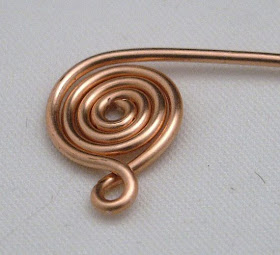When we wire wrappers make a spiral, we rarely are thinking of the geometry of that shape. We rarely count how many coils around we are going or whether or not it is symmetric. We are mostly focused on making it pretty and keeping tool marks off of it.
When we want to control the size of the spiral, we often measure a length of wire and than spiral that length, but we don't usually count how many coils we have in the spiral. We don't usually stop and consider whether it is a symmetrical or asymmetrical spiral.
Depending on the needs of our design, we might need to take a closer look at the geometric properties that make up a spiral. The advantages to having a symmetrical spiral is that it will be evenly weighted and hang straight, it can be matched up with a circular finding or another symmetrical spiral, and symmetry can be a beautiful and unifying aspect of a design.

Let's start with something as elementary as counting how many coils we have in a spiral. When you have made one complete turn around the circle, this counts as one coil. A second complete turn around the circle counts as two coils.
Looking at our two coil spiral, you can see that on both the right and left hand sides of the spiral you have two widths of wire. This is also true for the bottom. Only the very top has a little extra wire where the third coil would begin. This is an example of a symmetrical spiral, because all sides are even.
Now what happens if I begin a third coil but only go partially around the circle? You can see that the left hand side has three widths of wire, while the right hand side only has two widths of wire. This is an example of an asymmetrical spiral. Anytime that you do not go all the way around the circle, your spiral will be
asymmetrical.

Now lets say you wanted to take a matching asymmetrical spiral and flip it over to mate on the other side, or mate it to a a circular finding. You can see what happens in the following picture. The side that has three widths of wire is now trying to mate with the side that has two widths of wire. It doesn't look nice does it? Nor does it mate in any way.

But if we take two symmetrical spirals and mate one to the other, they match perfectly!

Now, let's say you wanted to add a little loop in your spiral. First you have to decide where you want that loop to be in your design. You could make a loop right at the starting point of your next coil perhaps. It depends on the needs of your design.
If you wanted to keep coiling after you made your loop, you have a couple of options. You can go all the way around the spiral and back to your loop and stay symmetrical, or you could go half way around the circle or any degrees you please and have an asymmetrical spiral again. It really depends on your design needs.

What if you did not want your loop to be right at the end of your last coil? But you still wanted to maintain symmetry? Let's say, for example, you wanted the loop to be at a 180 degrees location from the finish of the last coil.

The way to do that, is to spiral half way around your last coil, stop and make a loop, and than finish the last half of your coil. Now you have a loop right where you want it, while also keeping your symmetry.
TIP: If you have trouble keeping track of the start point of each coil, you can always draw on your spiral with permanent marker. Once you no longer need the marks you can remove with steel wool.









 Let's start with something as elementary as counting how many coils we have in a spiral. When you have made one complete turn around the circle, this counts as one coil. A second complete turn around the circle counts as two coils.
Let's start with something as elementary as counting how many coils we have in a spiral. When you have made one complete turn around the circle, this counts as one coil. A second complete turn around the circle counts as two coils.











